|
|
||||||||||||||||||
|
We need this manual PLEASE! Please contact us at info@smecc.org
TELEVISION EQUIPMENT THEORY AND OPERATION
Manual for
Television Technical Training Broadcast
Marketing Division ENGINEERING PRODUCTS DEPARTMENT
|
||||||||||||||||||
|
A SERVICE OF THIS WILL INFORM YOU ON Q&A ABOUT VIDEO TAPE COMMERCIALS NTA TELESTUDIOS LTD. TO TELL YOU: Editors Note: This Booklet Documents An Early Company That Produced Commercials for Agencies Outside the Network Environment - 1959/1960 |
||||||||||||||||||
|
|
||||||||||||||||||
GREAT Pair of Old 1950's Photos of Behind the Scenes NEWS Show on CBS. In the photos its so cool, you can see the people on the show live, you can also see the Camera Screen which also shows the people. On the wall it reads Westinghouse with clocks - can any one give us an exact date on these?
|
||||||||||||||||||
|
1945 Thornton Oakley "Television studios are realms of cameras and lights" National Geographic Society I was told that the print is about: 6 1/2" X 10"
|
||||||||||||||||||
 TELEVISION ON THE MOON!
TELEVISION ON THE MOON!
Or... In Space No One Can Tell You Are Using The CBS COLOR SYSTEM!
The Search for the original Apollo 11 Moonwalk TV tapes http://www.honeysucklecreek.net/Apollo_11/tapes/Apollo_11_Tape_Search_Flyer.pdf Neil Armstrong reads the plaque on the ladder of the LM – a Polaroid photo of the TV picture received by the Parkes Radio Telescope. Note the uniformly bright, detailed picture, including the reflection of Neil and the LM in Buzz Aldrin’s visor (center). Right: A frame of the official NASA recording, after the TV had been processed and relayed to Houston. This is what the world saw. and.. http://www.honeysucklecreek.net/Apollo_11/tapes/index.html http://www.honeysucklecreek.net/ http://www.honeysucklecreek.net/Apollo_11/tapes/index.html |
||||||||||||||||||
|
Richard
Hess linked to a report from this site on July
14th. I couldn't get that link to work. But there is an
alternate link provided on an associated page.
It looks as if my assumption was correct, the Apollo
moon landing tapes were sent to NARA's Federal Records Center in
1970, then called back by NASA some time beween 1975-1979, when NASA
pulled back almost all of a large series of records. The moon
tapes should have gone back to the FRC and eventually been
accessioned into NARA as "Permanent," but this never
happened.
See
for a site which has a flyer, a report, and the actual
NARA SF 135 records transmittal form. The form is at
The flyer is at
The full report is at
http://www.parkes.atnf.csiro.au/apollo11/The_Apollo11_SSTV_Tapes_Search.pdf
I'm still downloading it now; it's a large file and I only have dial-up. If I have any further observations, I'll send 'em along.
It would have been much safer for the tapes to have
remained at the FRC, you can see they have good item control over such
materials when they are held in NARA facilities.
Maarja
|
||||||||||||||||||
|
||||||||||||||||||
|
|
||||||||||||||||||
Search Is on for Original Apollo 11 FootageRead the article - hear the NPR radio program on this issue! http://www.npr.org/templates/story/story.php?storyId=5578853 |
||||||||||||||||||
|
DOCUMENTATION LIBRARY From the site of: 
Edited by Eric M. Jones see this fantastic site in total at http://www.hq.nasa.gov/office/pao/History/alsj/
Apollo TV and Communications Documentation
Unless otherwise noted, documents scanned and converted
to PDF format by Bill Wood. (See the accompanying notes
on the conversion process ).
|
||||||||||||||||||

This is a painted pressed steel toy NBC Television camera truck from the 1950s-60s
Each Wednesday and Thursday night, households would tune in to see exciting live theatrical productions. However, before each episode, an animated little Kraft TV cameraman would roll across the bottom screen with its "K" embossed camera spinning. He became so popular that viewers would call to request a souvenir of the little guy. Finally in 1954, Kraft produced this premium. All it cost was 50 cents and the end flap of a Velveeta carton!4" HIGH, 5" LONG, 2" WIDE
PLATE PROOFS All Tonga stamps issued after 1980 were perforated. Unlike other countries, Tonga did not issue both perf and imperf stamps, they were all perforated, none were issued imperf. However, at the beginning of each printing run, the printers Walsall Security Printers of London, used the printing plates to print off one imperf plate proof sheet for checking purposes before the main printing run. This plate proof sheet was not perforated, and was checked by the printers for any mistakes and for clarity of colour. After checking, this first sheet was not perforated, but was left imperf., and was then placed in the printers archives. The item here has been taken from the printers imperf plate proof sheet, and is a very scarce item from the printers archival material. History via - gej1949 in Moreton, QLD, Australia
|
||||||||||||||||||
|
||||||||||||||||||
|
W6UZO Amateur Radio Television
Note the 'creative' use of military surplus parts and cabinetry to build this camera.. Kudos to this pioneer! WAS MENTIONED THAT THEY WERE TAKEN IN THE WENTSWORTH STORE IN THE WESTCHESTER DISTRICT OF LOS ANGELES
|
||||||||||||||||||

Remington Rand's Vericolor, a closed circuit television camera developed in conjunction with CBS for industrial use. |
||||||||||||||||||
 Reprinted
from QST March 1946 in TELEVISION
INTERFERENCE By Remington Rand Labratory of Advanceed Research
Aprox. 1952 (EL108B) Reprinted
from QST March 1946 in TELEVISION
INTERFERENCE By Remington Rand Labratory of Advanceed Research
Aprox. 1952 (EL108B)
Military Television Cameras-and the Amateur BY A. DAVID MIDDELTON,* (* Department Editor.)W20EN LEFT> One of the original 2-inch Iconoscope amateur television camera units. Circuit details were almost identical to those described in October, 1940, QST.
GUIDED-MISSILES have long been a dream of the fighting services. One obstacle in the path of their research was the lack of a suitable and effective "eye" in the controlled missile that could scan the scene and transmit this intelligence to the control operator who could then correct for any possible deviation in direction.Such an "eye" was finally supplied in the form of compact, light-weight, expendable television camera units which could be attached to or installed in a remotely-controlled missile such as a robot bomber, a glide bomb or a high-angle bomb. Two outstanding facts become evident in an analysis of the background of one such equipment. The first includes the inquisitiveness and ingenuity of the radio amateur that led him to delve into the mysteries of television. The second demonstrates the foresight and courage shown in QST's program to present amateur television in a manner designed to stimulate the radio amateur's activities along these lines.These two features combined to produce the type of compact, light-weight military missile-borne television camera equipment shown in the photographs.From the radio amateur's laboratories came the incentive. the original designs. applications and construction technique and radio amateurs initiated, nurtured, developed and carried through a program of research, development and production of television camera equipment in the Electronic Division of Remington Rand at Middletown, Conn.Among the first amateur television transmission experiments were those made by W1BCR, about 1932. This station transmitted television pictures on 160 meters utilizing a 48-hole scanning disc. These signals were received by various New England amateurs. including Philip S. Rand, W1DBM. Television transmissions were directed to definite stations and these stations answered back on 160-meter 'phone and described the character of the picture received. In those days it was considered an exceptional feat if the receiving station could identify and describe any details of the received images. Rand said recently, "I'll never forget the thrill when, at the end of a Falmouth Radio Club meeting at my shack, we tuned in on 160 meters for a few QSOs. Upon hearing the characteristic buzzsaw note I switched in the neon tube and after synchronizing the scanning disc we saw through a magnifying glass, my call, W1DBM, spelled out in big characters. W1BCR was 'calling' me by television! 1 answered on 160-meter 'phone and he replied by televising some Mickey Mouse cartoons in black and white. ,.In the latter part of August, 1940, while Rand was in Washington, he made inquiries on the possibility of controlling, by radio, bombs and other missiles so that they might be directed to their targets more accurately than with a bombsight. W1DBM had read Sherman's article in QST on a new electronic television transmitting system for the amateur and also Lamb's article on a new iconoscope for amateur television cameras. During a discussion with a naval officer concerning the possibility of guiding a bomb by radio remote control, Rand was told "that this would not be feasible due to the difficulty in seeing the falling bomb from a plane and hence the difficulty of estimating its probable striking point." This original opinion later proved incorrect. (The Army recently announced successful remote-controlled bombs known as the Azon and Razon. The difficulty in seeing bombs fall from the plane was overcome through the use of a smoke flare in the bomb.)
|
||||||||||||||||||
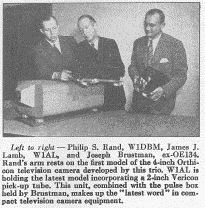
Left to right -Philip S. Rand, WIDBM, James J. Lamb, WIAL, and Joseph Brustman, ex-OEI34. Rand's arm rests on the first model of the 4-inch Orthicon television camera developed by this trio. WIAL is holding the latest model incorporating. 2.inch Vericon pick-up tube. This unit, combined with the pulse box held by Brustman, makes up the "latest word" in compact television camera equipment.
As Rand sat there having his remote-controlled bomb idea picked to bits he recalled his amateur television interest and amateur television's recent publicity in QST. He countered that if a television camera could be built small enough to be put in the nose of the bomb then the bombardier would not have to worry about visually following the bomb in its fall but could see, on a television screen in his plane, the exact spot at which the bomb was hitting. Rand returned home, approached company officials, and was assigned the job of building an amateur television outfit to test the feasibility of building television cameras small enough to fit into a bomb. Due to the military secrecy surrounding such projects, Rand was unaware that research groups, having vast resources and engineering personnel, were also engaged in the development of television camera equipment for missile-borne use. In true amateur fashion Rand started on the project without the aid of outside sponsorship and satisfactory equipment was actually developed before any agency was sufficiently interested to offer any aid. A project had been started by H. J. Rand (W1DBM's nephew) utilizing' a two-inch amateur "ike" for picking up objects through fog and darkness by infrared rays. Experiments determined that the two-inch amateur "ike" was not particularly sensitive in the infrared region and therefore was of no value for this purpose and this equipment was made available and the television camera project got under way in September, 1940 with W1DBM and H. J. Rand as co-workers. . Tests disclosed that the two-inch amateur "ike" lacked sensitivity and definition for high quality pictures. This operating defect was brought home forcefully late one afternoon when demonstrating the equipment. There was insufficient light outdoors to get a decent pick-up. However, upon tuning in NBC's television they saw an excellent outdoor picture of a football game. Upon investigation it was learned that NBC was using an Orthicon type of pick-up tube. Samples of these tubes were procured and work started on a small camera utilizing this more sensitive pick-up. By now, the project had grown considerably and additional personnel was required. J. J. Lamb, W1AL, of QST, had been working on amateur television and was a logical choice. He was engaged on a consulting basis and later secured a leave of absence from the ARRL to devote full time to the project. Next came Joseph Brustman, ex-OEI34, a native of Vienna, Austria, a man with wide television experience. H. J. Rand dropped out to begin work on another project. Later he joined the. Army Air Forces. Toward the end of the war, with the rank of major, Rand actually controlled television guided missiles in the ETO.The first model utilizing a four-inch Orthicon was completed in the spring of 1941 and given vehicular tests transmitting back to the laboratory on 105 Mc. This camera unit weighed about 65 pounds as compared to the then existing "portable" commercial equipment comprised of six or seven large-size suitcases weighing a total of some 700 pounds. This midget television equipment was demonstrated to the armed forces but they did not appear particularly enthusiastic about such a "fantastic idea." However, the OSRD and the NDRC thought it worth while. They could not sponsor a completed project but if a smaller and lighter camera could be made it would be a new development which NDRC could sponsor. A new type of Orthicon pick-up tube had been experimentally made by Dr. H. B. DeVore of RCA, and this tube was used in a considerably smaller television camera subsequently developed for and demonstrated to the NDRC by the Middletown group. Early in 1942, Vernon Chambers, W1JEQ, obtained a leave of absence from QST and joined Rand and Lamb, as did Harry Whittemore, W1BR. By late spring it became apparent that more of the two-inch Orthicons would not be available from RCA, so it became necessary to manufacture them and Marshall P. Wilder, W2KJL, started the production of the desired pick-up tubes, assisted by Frank Norman, W1JZB. Daniel Smithwick, jr., W1NKA, went to work on construction of the cameras as did Calvin Bennett, W1KHL. August, 1943 brought George Grammer, W1DF (obtained on leave of absence from QST) and later Milton Bloomquist, ex W2BAI, joined Wilder's vacuum-tube section. John S. Muskatallo, W1BFW, and Thomas S. Pugarelli, ex-W2LWL, also were included in the project. Approximately fifty workers, men and women, were finally engaged in the manufacture and development of this equipment.
|
||||||||||||||||||

Phil Gildersleeve, W1CJD, city editor of the Middletown Press and famous QST cartoonist, holds one of the 2-inch Vericon cameras during a recent demonstration of the equipment to the press. The cord stretched along the unit is part of the automatic iris control system.
After the Germans began using their robot bombs the Army and the Navy became intensely interested in remotely-controlled guided missiles and the Middletown group was given contracts by both services to develop still smaller and lighter weight units. Various models built concluded with the latest and smallest model comprised of two pieces; one, a long slim box containing the camera and the video amplifier and a smaller square box housing the pulse and synchronizing signal generator. The outstanding characteristics of these units are their small, compact and light-weight construction and features such as the automatic iris control and the automatic focusing control. These units will stand temperatures from -500 to +500 C. as well as centrifugal force up to 10 Gs. Circuit details are still shrouded in military secrecy. Both the Army and Navy have disclosed some of the uses to which equipment of this type has been subjected, including details on the high angle television bomb, the glider bomber, (called a "Glomb") and the television-equipped robot plane. One actual use of the equipment might be as follows: A suitable bomb (maybe 2000 pounds) has a streamlined housing strapped under it. This contains the camera head. A wing of sufficient lifting capability, to maintain a glide of possibly 6 to 1, is strapped on top. Fastened to the rear of the bomb is a fuselage containing the pulse box, transmitter and a remote-control receiver together with motors and solenoids for controlling the rudders and fins which project from the rear of the fuselage. This is the so-called" glide bomb" which is carried to within gliding range of the target. The bombardier switches on the television apparatus and when he is within gliding range of the target he releases the glider. At this time the bomber circles away and gets out of range of enemy AA fire and fighter planes. The operator ill the bomber synchronizes his television receiver with the transmitter and holds it synchronized while the bombardier, looking at a separate monitor 'scope in a darkened part of the cabin, throws switches on his remote-control apparatus and changes the glide bomb's path - up or down or right or left so that the target is centered on the crosshairs on his picture 'scope. Meanwhile the bomb, gliding at a speed of some 200 or 300 m.p.h., approaches the target. The target looms larger and larger on the 'scope in the plane and the bombardier makes minute corrections as various cross winds throw the bomb off course. Suddenly the ground seems to leap up and hit the observer in the face. The scene disappears in an enlarging close-up as the camera is destroyed. And so is the target!The camera unit can be installed in the nose of a robot plane, complete with motors and all the necessary controls. The robot is flown off the ground by remote radio control or by a pilot who parachutes to earth after flying the plane off the ground. The two planes now fly hundreds or even thousands of miles until they come to the target area. Then the operator flies the robot plane, carrying a heavy charge of explosives, right into the target, guiding the robot by the view of the area ahead as received over the television circuit. Television may also be used in the so-called high-angle bomb carrying a television camera in front of the" war head" and with the associated equipment in the bomb's tail portion. This bomb has no wings but has controlling devices on the tail. The bomb is dropped from 25,000 to 30,000 feet by a standard bomb sight and theoretically would hit the target without any remote control. However, unknown cross winds and unknown temperatures at lower levels often cause high elevation bombs to miss their target, therefore the bombardier utilizes television to see in what direction the bomb deviates and then corrects its trajectory by remote control.
|
||||||||||||||||||
|
Many amusing incidents occurred in connection with the
development and testing of this equipment. One day when parked on a hill
about five miles away from the lab, W1DBM tried frantically to raise
the lab on the 112-Mc. talkback circuit However, those viewing the images
had become so engrossed that they paid no attention to the voice circuit.
Rand then thought of a simple way of "raising" them. He got out
of the truck, walked around to the front and pointed first at the camera
and then at his ear, meanwhile making talking motions with his mouth. The
lab called him before he could get back into the truck! Another day while
demonstrating the equipment W1DBM was driving with the camera turned on.
The television camera, mounted inside a station
wagon, had its lens about two inches away from the windshield. Suddenly it
began to rain so hard that the windshield wipers were ineffective. Rand
stopped because he couldn't see beyond the radiator cap and the talk-back
speaker barked, "Don't stop there! Continue to your location."
Rand informed his base that he couldn't see where he was going due to the
rain. They replied, "That's funny, we can see all right."
The windshield, so close to the lens that it was out of focus, acted more like a neutral density filter and while it cut the light in half, it still permitted vision outside the windshield. On one occasion during a flight in the Connecticut valley the test plane seemed to be losing altitude so the pilot was ordered to climb back up to his original altitude. The pilot radioed back that he couldn't see the ground through the haze and so would continue to come down until he could establish his position. But he halted his descent when he learned that a good picture of the Connecticut River was being transmitted to the ground and the men on the ground could give him instructions as to his course. Many problems had to be solved and serious difficulties overcome before a television camera could be made as small and as light-weight as the final models shown in the accompanying photographs. One of the tough problems was that of automatically adjusting the iris in the lens to the various changing light conditions encountered by an airborne television camera. Another serious problem was the constant battle to reduce size and weight. This was so vital that one of the slogans of the lab was, "Cut it in half!" The engineers were constantly on the watch for smaller tubes, resistors, condensers and other components and searching for new layouts which could reduce the physical size and weight. Another important detail was that of maintaining the right temperature range. It was necessary to install thermostatically-controlled heated jackets on the lens and on some of the other components before the temperature problem was licked. The equipment was required to withstand all the abuse put upon airborne radio through the severe vibration and high noise levels. Extensive tests on vibration tables and in acoustical boxes were conducted and, one by one, the offending parts or circuits were eliminated. Probably the most important problem was that of dispensing with the usual three or four television engineers and operators that, in the past, accompanied so-called "portable" apparatus. This camera unit had to be fully automatic as the only adjustment permitted was that of turning on the power supply. But these perplexing problems were overcome by this group of radio amateurs in their development of television camera equipment. Inspired by amateur television experiments, developed and "followed-through" by amateurs, this type of equipment may well prove to have many useful functions in a peacetime world, in spite of the fact that it was originally conceived to aid our country in battle. It is truly another worth-while contribution made by the radio amateur in the battle of the laboratory and the production floor. -end-
|
||||||||||||||||||
|
Scott
Time-lapse Box - U.S. Patent 4 271 437 By Xen Scott
|
||||||||||||||||||
|
Televisa Silver camera, award? trophy? desk ornament? You tell us what the history is on this. Due to the logo probably was made Drop a note!
|
||||||||||||||||||
 Does
anyone know what this trophy is for? It is a television related
award. We have one that might indicate is is from Spain or Latin American
Television or video production? Does
anyone know what this trophy is for? It is a television related
award. We have one that might indicate is is from Spain or Latin American
Television or video production?
|
||||||||||||||||||
The Videotape Recorder Turns 50Routine NAB preview event showcased revolutionary technology
|
||||||||||||||||||
| http://www.tvtechnology.com/features/news/2006.04.12-n_the_video_tape_02.shtml | ||||||||||||||||||
|
Tell us about this card and these stations... KSAR-TV
and KSBK in Okinawa. Drop me a note!
|
||||||||||||||||||
Maricopa Colleges Television awarded for excellence in productionMaricopa Colleges Television (MCTV) has received two prestigious awards highlighting outstanding television production. MCTV is the Maricopa County Community College District’s cable television station that provides programming to viewers throughout the Phoenix, AZ, metropolitan area on Cox Communications Digital Channel 115. Information about MCTV can be found at www.maricopa.edu/mctv. The station has garnered the bronze Telly Award in the 27th Annual Telly Awards competition. The award honors excellent local, regional and cable television commercials and programs, as well as the finest video and film productions. MCTV was recognized in the Live Event category for coverage of the 13th Annual Gene Autry Courage Awards, held in Tempe in March. MCTV’s Torsten Voss was the lead producer of the program. MCTV was among more than 12,000 entrants from 50 states and five continents who participated in the Telly Award competition. In addition to the Telly Award, MCTV also recently received the winner’s trophy in the 16th Annual Aegis Award competition, which honors outstanding television and video production. The award criteria focuses on several elements of production, including shooting, editing, and use of music. MCTV received the Aegis Award for a series about Arizona state historian Marshall Trimble that was featured on the station’s news magazine show “Maricopa Now” in February, April and March. There were more than 3,000 entrants vying for Aegis Award recognition. “We are proud to accept these awards that honor the hard work, creativity and talent of the MCTV staff. These awards are a testament to the fine, high quality programming MCTV brings to viewers on behalf of the Maricopa Community Colleges,” said René Blatte, MCTV director. |
||||||||||||||||||
|
Release - ARIZONA INTERNET NEWS COMPANY WINS TELLY
|
||||||||||||||||||
 |
||||||||||||||||||
| The Business Journal of Phoenix -
July 10, 2006 http://phoenix.bizjournals.com/phoenix/stories/2006/07/10/story16.html
Glendale filmmaker receives national media award CouryGraph Productions received a Bronze Telly Award for a short documentary on the Glendale Fire Department Safety House, a film trailer used to educate people about fire safety at various locations around the city. The Telly Awards honor outstanding local, regional and national cable TV commercials and programs, as well as video and film productions. The program receives more than 12,000 entries each year from all over the country. Ed Sharpe, director of Glendale-based CouryGraph, said this was his first year entering the contest. The 14-minute film focuses on fire department volunteer Dennis Davis, who uses the trailer to train children and adults on how to escape from a burning structure. The film is available on The Glendale Daily Planet, an Internet video news source which Sharpe manages. For more: www.glendaledailyplanet.co.
|
||||||||||||||||||

The Glendale Star June 22, 2006 - B5 Local Internet Video News Company Wins Telly Ed Sharpe director of CouryGraph Productions, who oversees The Glendale Daily Planet - KKAT Streaming TV, Glendale's homegrown Internet video news source, received the Bronze Telly Award as recognition of his programming. The Telly Award honors outstanding local, regional and national cable TV commercials and programs, as well as video and film productions. The award organization annually showcases the best work of advertising agencies, production companies, television stations, cable operators and corporate video departments. Sharpe and CouryGraph Productions received the Bronze Award for a 14minute movie documenting The Glendale Fire Department Safety House. Glendale Fire Department Volunteer Dennis Davis, who teaches the fire safety class involving this vehicle, was the subject of the video. The Telly Awards receives in excess of 12,000 entries each year from 50 states and foreign countries. "It is honor to receive a highly respected national award for work in publicizing events that take place in the city of Glendale," Sharpe said. "The Telly awards highlight the high standards of excellence we wish to achieve. In addition, it is our wish to provide our viewership with information they can trust and enjoy." The Glendale Fire Department Safety House trailer was purchased with a FEMA Grant and provides realistic training for youth and adults on escape tactics from burning structures. Dennis Davis, Glendale Fire Department volunteer and class teacher, travels around the city to schools and adult centers introducing and refreshing people on the wisdom of fire safety. This unique training aid is often on display at city events. In addition, earlier this year, The Glendale Daily Planet was the recipient of a bronze Millennium Award, and CouryGraph Productions netted a silver Millennium award for a movie on Glendale Gaslight Inn. The work of CouryGraph Productions and other participative community journalists may be viewed 24 hours a day, seven days a week at www.glendaledailyplanet.com.
|
||||||||||||||||||

This is an original 1928 color cover for the Science and Invention Magazine dated November, 1928, Vol. XVI, No. 7. This cover was illustrated by Pattiani, R. E.
|

|
|||||||||||||||||
|
SMECC Needs 1940s 50s Television Microwave Relay equipment
Please email us at info@smecc.org
|
||||||||||||||||||
|
Philco 1946 Philco Television WPTZ Philco built
Camera (Book from SMECC Collection)
|
||||||||||||||||||
|
Jim, a retired Pac Bell employee sent this
in..."
I found this PacBell FasTrak Video Services pin at the bottom
of a box of books in my closet that I brought
over from my old
apartment. It's brass, and about the size of a
postage stamp,
so it could be used as either a tie-tak or a lapel pin."
I have no idea why they used the image of a FILM
camera to promote a VIDEO service.

FasTrak Video Services was a high-speed
(300mb/s)
digital data service they began marketing in 1998 that
was
specifically 'tweaked' for sending large video files
between
production companies & editing houses that had
converted
to 'digital editing' at that time. It was also
extensvely used
'live' during the 1998 Acadamy Awards telecast. It was
also
marketed to big corporations for use as a 'high
definition'
video conferencing network.
It cost between $750-$1200 to install, depending on your
location & needs, and $125/mo after that. It has
since been
phased out & replaced by a fiber-optic based
high-speed network.
|
||||||||||||||||||



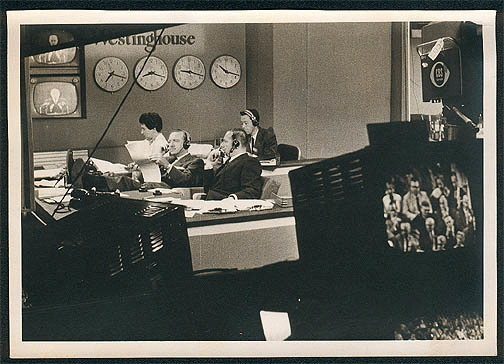




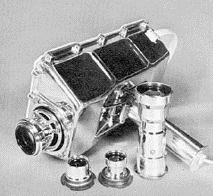


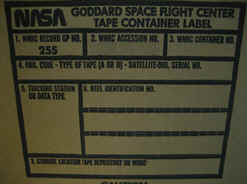



















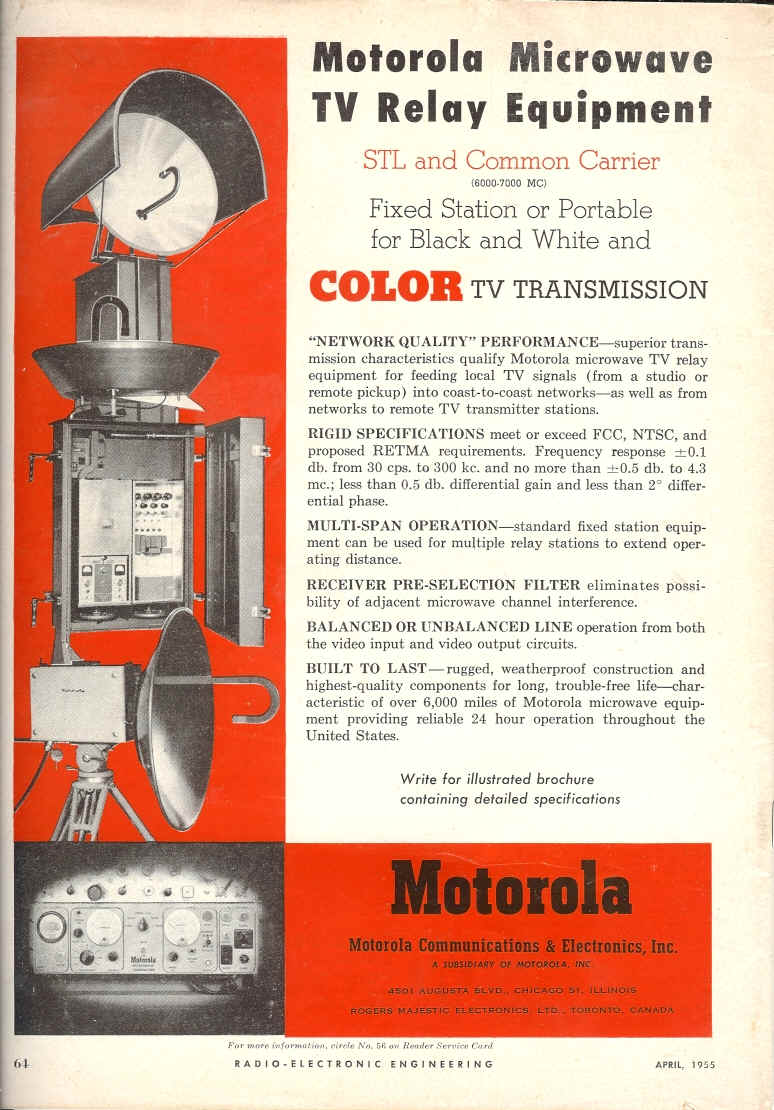
 The
Servicing of Television Receivers
The
Servicing of Television Receivers 